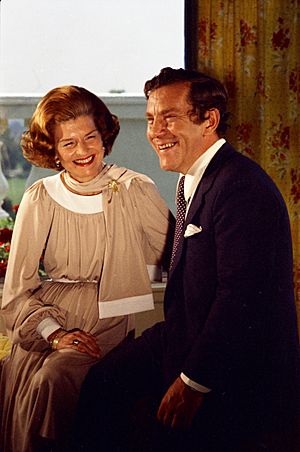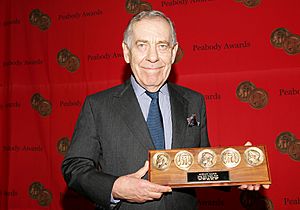Morley Safer facts for kids
Quick facts for kids
Morley Safer
|
|
|---|---|

Safer at the LBJ Presidential Library, 2010
|
|
| Born | November 8, 1931 |
| Died | May 19, 2016 (aged 84) |
| Resting place | Roselawn Avenue Cemetery, Toronto |
| Nationality | Canadian, American |
| Alma mater | University of Western Ontario (dropped out) |
| Occupation | Broadcast journalist, reporter and commentator |
| Years active | 1955–2016 |
|
Notable credit(s)
|
60 Minutes (1970–2016) |
| Spouse(s) |
Jane Fearer
(m. 1968) |
| Children | 1 |
Morley Safer (born November 8, 1931 – died May 19, 2016) was a famous Canadian-American broadcast journalist. He was a reporter and correspondent for CBS News. Morley Safer was best known for his long time on the news show 60 Minutes. He joined the show in 1970. He was the longest-serving reporter on 60 Minutes. This show became one of the most watched and successful programs in TV history.
During his 60-year career, Safer won many awards. These included twelve Emmys and a Lifetime Achievement Emmy. He also won three Overseas Press Awards and three Peabody Awards. He died just one week after saying he would retire from 60 Minutes.
Jeff Fager, the boss of 60 Minutes, said Morley had a great career. He was an important person in CBS News history. Fager said Morley's curiosity and writing made his work special.
Contents
Early Life and Education
Morley Safer was born in Toronto, Ontario, Canada. His family was Austrian Jewish. His parents were Anna and Max Safer. Max was an upholsterer. Morley had an older brother, Leon, and an older sister, Esther.
When he was young, Morley read books by Ernest Hemingway. He decided he wanted to be a foreign correspondent, like Hemingway. He went to high school in Toronto. He also briefly attended the University of Western Ontario. However, he left college to become a newspaper reporter. He once said, "I was a reporter on the street at 19 and never went to college."
Starting a Journalism Career
Safer began his journalism career in 1955. He worked for newspapers in Ontario, Canada. He also worked for newspapers in England. Later, he joined the Canadian Broadcasting Corporation (CBC). He worked there as a correspondent and producer.
Reporting International News
One of his first jobs with CBC was in 1956. He helped produce CBC News Magazine. His first time on TV was covering the Suez Crisis in Egypt. In 1961, he worked from London. He covered big stories in Europe, North Africa, and the Middle East. This included the Algerian War for independence. In 1961, he was the only Western reporter in East Berlin. This was when the Communists started building the Berlin Wall.
In 1964, CBS hired Safer. He became a reporter based in London. He worked at the same desk once used by the famous journalist Edward R. Murrow.
Covering the Vietnam War
In 1965, Safer became the first full-time reporter for CBS News in Saigon. He was there to cover the growing Vietnam War. By 1967, he became the CBS bureau chief in London. His news stories covered many global conflicts. These included the Nigerian Civil War and the Six-Day War in 1967. He also covered the Warsaw Pact invasion of Czechoslovakia in 1968.
Safer and his team were the first U.S. journalists to report from inside Communist China. This was shown in 1967 as a special CBS News Report. It was called "Morley Safer's Red China Diary."
The Burning of Cam Ne
Safer's report from Vietnam in August 1965 was very important. It was called "The Burning of Cam Ne." He went with a group of Marines to a village. Their mission was to "search and destroy." When the Marines arrived, snipers shot at them. The Marines told the villagers to leave. Then, the Marines burned the village down.
Safer's report was one of the first to show a sad picture of the Vietnam War. It showed innocent people as victims. Many American military and political leaders did not like the story. They said it hurt the United States. President Lyndon B. Johnson was very angry. He called CBS's president. He said Safer and his team had hurt America's role in the war.
Some former Marines who saw the story disagreed with Safer. They said Safer did not know the full story. They claimed four Marines had already died there. Twenty-seven others were hurt. They said the village had been warned many times. They were told the village would be burned if they kept shooting at Marines. But this was not in Safer's story.
Safer later said that officials denied his report. They claimed he had gone to a fake village. Or that he had made up the whole story. He said, "There are still people who believe that." After this report, Marines were not allowed to burn villages anymore.
While reporting another story in Vietnam, Safer was in a helicopter. It was shot down by enemy fire. Safer and two cameramen were not seriously hurt. A general who worked with Safer said he was "cool as a hog on ice."
Safer won an Emmy Award in 1971 for his report on the Gulf of Tonkin incident. During his career, Safer covered over nine wars. He also wrote a book called Flashbacks: On Returning to Vietnam. It talks about his trip back to Vietnam in 1989.
Becoming a 60 Minutes Reporter

In 1970, CBS producer Don Hewitt asked Safer to join 60 Minutes. Safer was covering a funeral in Paris at the time. He accepted the new job. The show had only been on for two seasons. Safer had always reported alone before this. He said he would take the job only if he could get his old job back if the show failed.
Over the years, other famous reporters joined 60 Minutes. These included Dan Rather, Mike Wallace, and Diane Sawyer. 60 Minutes became the most watched and profitable TV show ever.
Safer was known for his friendly and polite way of interviewing. This allowed him to ask tough questions that regular viewers might ask. He always worked hard to find facts for his stories. He often added his own thoughts to reports. But he always kept high professional standards. This helped set the style for 60 Minutes. He even typed his stories on a manual typewriter. He traveled a lot for his stories, sometimes 200,000 miles a year.
Don Hewitt said Safer had a "great eye for stories." He could find interesting stories. For example, he did a piece about Finns loving the tango dance. He also did serious reports. One report helped save a man's life in Texas. In 1983, Safer reported on Lenell Geter. Geter was a 25-year-old black engineer. He was in prison for robbery. Safer looked into the case. He found things that did not make sense. He also saw possible unfairness because of race. After Safer's report, Geter was released in 1984.
Safer won many Emmys for his 60 Minutes stories. These included "Pops" (1979) and "Teddy Kollek's Jerusalem" (1979). He also won for "Air Force Surgeon" (1982) and "It Didn't Have to Happen" (1982). In 1994, he hosted a CBS News Special. It was called One for the Road: A Conversation with Charles Kuralt and Morley Safer. This marked Kuralt's retirement.
Safer retired after 46 years with CBS. He died a week later. He holds the record for the longest-serving reporter on 60 Minutes. A few days after he retired, CBS aired a special show. It was called Morley Safer: A Reporter's Life.
During his 60-year career, Safer won every major award in broadcast journalism. He received a Lifetime Achievement Emmy in 1966. This was special because he was only 35. This award is usually given after a whole career.
The Morley Safer Award
In January 2019, the Morley Safer Award was created. It is a program of The University of Texas at Austin's Briscoe Center for American History. Safer's old papers are kept there. The award looks for stories that show creativity, vision, and honesty. The award is given out each fall in Manhattan.
Personal Life
Morley Safer married Jane Fearer in 1968 in London. Jane was an anthropology student. They had a daughter named Sarah Alice Anne Safer. Sarah graduated from Brown University in 1992. She is also a journalist.
Morley Safer was a citizen of both Canada and the United States.
Death
Morley Safer died at his home in New York City on May 19, 2016. He died from pneumonia. This was just eight days after he announced his retirement from 60 Minutes. Four days before he died, CBS aired a special 60 Minutes episode. It covered Safer's 61-year journalism career. Safer was buried at Roselawn Avenue Cemetery in Toronto.
Awards and Recognition
- 12-time Emmy Award winner
- 3-time Overseas Press Award winner
- 3-time George Foster Peabody Award winner
- 2-time Alfred I. duPont–Columbia University Award winner
- Winner of the Paul White Award from the Radio-Television News Directors Association (1966)
- Received a Lifetime Achievement Emmy from the National Academy of Television Arts and Sciences (2003)
- Received the 2003 George Polk Memorial Career Achievement Award from Long Island University
- Won the Robert F. Kennedy Journalism Awards' first prize for domestic television. This was for his report "School for the Homeless."
- Named a Chevalier dans l'Ordre des Arts et des Lettres by the French government in 1995. This means "Knight in the Order of Arts and Letters."
- Received Brown University's Welles Hangen Award for Superior Achievement in Journalism (1993)
- Received The International Center in New York's Award of Excellence
See also
- Betty Ford's August 1975 60 Minutes interview


